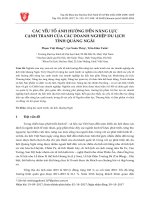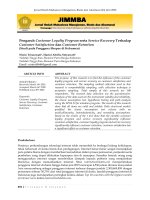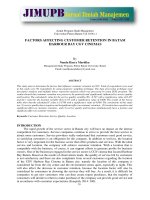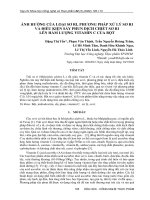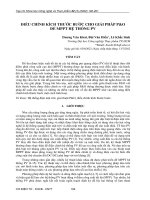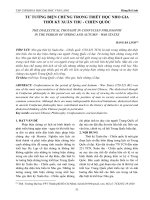1183 article text 3274 1 10 20201126
Bạn đang xem bản rút gọn của tài liệu. Xem và tải ngay bản đầy đủ của tài liệu tại đây (1.48 MB, 7 trang )
IJRTBT
INFLUENCE OF SOCIAL MEDIA ADVERTISEMENT ON
CUSTOMER'S PURCHASE DECISION: A LITERATURE REVIEW
Kumar Shubhangam¹*, Manisha Srivastava², Ritesh Ravi³, Ravinjit Singh⁴
1,2,3
Amity University Patna, India
Lincoln University College, Malaysia
4
*Corresponding Author's Email:
ABSTRACT
In today's world, the social media is changing the traditional way of marketing and advertising the products as
well as services. There is a huge increase in the usage of social media from past few years. The social media
helps customers to search and compare any information and thus it is removing away the traditional form of
media like radio, magazines, television, and newspaper. Therefore, there is a need for creating effective online
advertisement strategies to increase the capital of the current market scenario by introducing more efficient
features in social media advertising. This dissertation is about the theoretical form of contributions and
development of a new conceptual model over the past research carried out related to social media
advertisements and purchase decision of customers. This dissertation basically focuses on the features of
online advertisements and its influence on customer's purchase decision. On the other hand, the previous
studies have found different characteristics of online ads towards purchase intention and attitude of customers.
With the help of this study, an entirely new concept of consumer's buying intention towards social media
advertisement has been developed. This study also shows that the influence of social media ads varies
accordingly with different stages of consumers' decision-making process to purchase any product or service.
Further, the conceptual model shows that the features such as information, entertainment, trust, reward and
satisfaction affect the electronic word of mouth along with the brand equity of any product or service which is
available on the online platform. In this study, secondary information has been collected in the form of
literature review, research approach is qualitative and exploratory research design has been conducted to
collect the information from the past data available in various research papers.
Keywords: Advertisements, Electronic Word of Mouth, Consumers, Brand Equity, Purchase Intention,
Social Media
INTRODUCTION
Meaning
Social media advertisement is a type of digital
advertisement which has become one of the most
effective means of advertising through internet in an
online platform. This type of advertisement is spread all
over the globe. It is the fastest and newest way for
advertising. Nowadays, internet provides a direct link on
various sites for advertising the products or services. The
provision for pay per click advertising is also available.
Social media advertisements are displayed in a unique
manner so that the customers visit the advertisements
and show some interest. As compared to the traditional
modes of advertisement such as radio, TV, magazines
etc. the social media advertisement is mostly preferred
by the customers. Social media advertisement includes
text ads, image ads, pop-up ads, banner ads and HTML
adds. These all ads are dominant over other traditional
kinds of advertisement techniques. There are various
parameters such as hits, clicks which are used to
calculate the frequency of visit to any website and the
time spent on a particular website to predict the
consumer behaviour.
Reviews in the social media ads are one of the primary
factors for knowing customer's buying intention. These
reviews are widely available for judging any product or
service and it also creates a great value for both
companies and customers. It has been noticed that
customers also find it interesting to rate and review the
product or service online. This helps to build a good or
bad electronic word of mouth (e-WOM) which helps
the customers in their purchasing decisions.
This study is focused on understanding the influence of
social media advertisement on customer's purchase
decision. It will be useful to know whether the social
media advertisements lead to the purchase of
advertised products and services or not.
Background
Advertisement can be defined as a paid form of
International Journal on Recent Trends in Business and Tourism | Vol. 4 (4) OCTOBER 2020 | 25
IJRTBT SOCIAL MEDIA ADVERTISEMENT ON CUSTOMER’S PURCHASE DECISION
promotion which is done through various mass
mediums. Advertising consists of two components. The
first is the traditional one which means advertising
through offline channels such as radio, TV, newspapers,
and magazines. The second one is the latest that is
online advertising such as advertisement through
website, E-mail, banner ads, pop-up ads, text ads,
dynamic media etc. With the help of advertising,
marketers can create awareness and attitude about their
product or service which leads to increase in sales,
encourage customers and remind them to differentiate
various brands and position them accordingly in their
minds. Social media advertising has become one of the
most important tools for promotion.
Problem discussion
The growth of various social networking sites resulted
customers to access the other features like chatting,
messaging, gaming, and blogging. Presently, Facebook
is the most popular social networking site which
provide features such as constructing dynamic profiles,
forming groups, chatting, and sharing information to
others. So, the interaction over these social networking
sites leads to affect the buying decision of consumers
because they are in constant touch with their family
members, friends, co-workers and groups or
individuals. It also provides them a platform for
comparison of various products or services online and
this may hamper any company who is having a bad eWOM or negative reviews. Every day, consumers make
so many product purchase decisions and they also like
to take review from others also. Thus, the social
network provides customers a good platform to gather
information, advices, and reviews.
Objectives of the study
· To study the influence of social media
advertisement on consumer buying decision
making process.
· To identify the main factors which are affecting
the consumer purchase intentions influenced by
social media.
· To develop a new conceptual model of social
media advertisements and its influence on
customer's purchase decision.
LITERATURE REVIEW
Wang & Yu (2015) suggested that there are both
negative and positive reviews about the service or
product which affects the consumer's purchase
decision. In social media, word of mouth has a huge
impact on consumer's purchase intention to buy any
product. Thus, the word of mouth is very helpful in
sharing information about the product or services on
social networking sites. The study considers word of
mouth as one of the most important variables in
marketing. Further, framework model was also
developed according to this study in which the word of
mouth is a major component.
Harshini (2015) showed the analysis of the previous
theoretical form of research on social media
advertisements and customer's buying intention. This
study shows the few features of social media
advertisement and its effect on consumers buying
intention. It provides a collection of consumer's
responses towards social media advertisement with
respect to the customer's purchase intention. The paper
shows that the users of social networking sites found
this kind of advertisement technique very interesting
and they are also showing interest by responding to
those ads and purchase the products with help of those
advertisements.
Balakrishnan, Dahnil & Yi (2014) described that the
online groups, electronic word of mouth, various
internet communication and online publicity are very
much helpful to build the positive brand image and
consumer's buying intention with the help of social
media. This shows that the marketing managers must
reach to the customers of young generation and
consider social media as the best tool for selling. This
study provides information to various sellers before
applying it to social media advertisement technique to
market their product. The idea behind targeting the
young population is because most social media users
belongs to the younger age group and they are more
aware with the latest technologies coming up as
compared to the older generation. Hence social media
advertising is very beneficial for them as well as for the
firm who are targeting the audience.
Lee (2013) explained that the customers look
intensively for the information about the product on
social media sites with respect to any other mass media.
The search is more subjective and selective. The ads in
the social media also provide a platform for comparing
the products with the other brands also and this is this
feature is liked by almost all the social media users. The
information content about the product is also given in a
detailed form of specification which help customers to
know about the product very well and they can also do a
detailed comparison according to the specification they
are looking for.
Martinka (2012) depicted that an analysis conducted
between Facebook and Twitter groups. Both are
62 | Vol. 4 (4) OCTOBER 2020 | International Journal on Recent Trends in Business and Tourism
SOCIAL MEDIA ADVERTISEMENT ON CUSTOMER’S PURCHASE DECISION
famous social networking sites and they also influence
the purchasing behaviour of consumer. A survey was
conducted using 3-point Likert scale to know about the
various applications of social media. The final output
showed that the group present in social media control or
command over the traditional online purchase of
customer. The study also shows that Facebook has
greater impact on consumer's online buying behavior as
compared to Twitter. Thus, the social media
communities are very important target in the online
market.
Drell (2011) demonstrated that out of 100 per cent,
maximum information sharing of online shoppers were
20 percent and they were mainly teenagers who are
dedicated to the brands. The information sharing is
done with the help of various electronic equipment.
Although, minimum information sharing was 80 per
cent and they were mainly older people who only
focused on quality instead of brand. The findings also
showed that the teenagers not only interested in buying
the products, but they are also recommending the
products to others also which is very good according to
the company's point of view. The older generation are
not able to indulge more because they are not aware
about the changing trend of technology and they mostly
rely and trust on the traditional way of shopping in
stores or in market.
Webster (2011) described that twenty five percent of
social media users purchase their favourite brands via
various social networking sites out of which maximum
users prefer Facebook as their brand page. The analysis
shows that the social networking sites have become a
source of information for any product or service by
consumers. Most of the population using social media
trust more on Facebook because it offers more
interesting and convenient features as compared to any
other social networking sites. Thus, it helps customers
to buy the products according to their choice very easily
and at the same time it helps users to check the review
about the product they are buying. This helps to build a
trust in the minds of customers and hence it leads to
capture a majority of customer base.
Fotis (2015) described that the influence of social
media on buying behavior of customers with respect to
the tourism services. The analysis shows that for
vacation planning, social media platform is used
c o m m o n l y. T h e s o c i a l m e d i a a d s p r o v i d e
recommendations to the customers so that they could
choose an ultimate location for visiting. The social
media keeps a track and to pattern analysis which helps
to know about the taste and buying intention of
IJRTBT
customers as well as it also tries to give choices and
preferences according to the buying intention and
travel pattern of the customers.
Hoyer et al., (2010) revealed from the findings of the
study that the social media is a platform where
customers convey information to others by the help of
electronic word of mouth, recommendations, and
reviews. Thus, it is found that opinions and reviews
given by others in the social media is very important for
the buyers. It also helps to build trust on the group and
influence the buying decision process. On the other
hand, it also shows that few factors such as trust,
rewards, satisfaction, and credibility play a very
important role in building a positive or negative
electronic word of mouth which ultimately affects the
consumer's purchase intentions.
Bughin, Doogan & Vetvik (2010) described that the
social media advertisement has a great impact on
customers particularly who buy the product for the first
time. The social media ads are very helpful to do
analysis and comparison of high-end products before
purchasing them. As a result, customer will always use
social media to get data about the products and services
and they will always look for the good word of mouth
before purchasing any product or availing any services.
RESEARCH METHODOLOGY
Research Approach
Qualitative research approach has been adopted here
which was helpful for describing, interpreting, and
gaining in-depth insight into specific concepts of social
media advertisements and customer buying intention.
Research Design
Exploratory research design is conducted to collect
information from the past data available in various
research papers. It required to investigate different
sources such as published secondary data, data from
other surveys, observation of research items, and
various opinions.
Data Source
Secondary data was collected from various research
papers, journals, and articles. The data gathered from
these different sources was helpful in writing the major
findings and summary of the literature review.
Data Collection Method
The literature review is conducted by the effective
evaluation of various research papers, journals, articles
in social media advertisement. The review was
International Journal on Recent Trends in Business and Tourism | Vol. 4 (4) OCTOBER 2020 | 27
IJRTBT SOCIAL MEDIA ADVERTISEMENT ON CUSTOMER’S PURCHASE DECISION
collected from different parts of the research which has
been carried out. The background study was developed
with the help of literature review. After the evaluation
of these literatures, the required answers are found.
This literature review served as a predecessor to the
research.
DISCUSSION
Findings of the study
The social media has evolved as one of the most
important channels for the consumers to make the
decisions on buying of the products. The study was
carried out to test the influence of social media ads on
the purchase intention of the customers.
Results indicate that social media advertisements
significantly impact both purchase intention and brand
loyalty. It also shows that purchase intention of
customers affects the brand loyalty. These findings
offer new insights for both managerial and research
implications.
According to literature review, electronic word of
mouth (e-WOM), information, entertainment, trust,
reward, and satisfaction are the important variables
which influence the consumer purchase intention on
social media platform.
Relationship between social media ads and
consumer's purchase intention
The study also shows the relationship between social
media advertisement and consumer's purchase
intentions on a positive side. According to this study,
social media do not only help marketers to interact
efficiently with their target customers, but it also
motivates the readers to buy the products which are
being advertised. This is because social media offers
marketing techniques where readers can share product
information with their friends and families and such
information is more reliable and credible.
Learnings of the study
According to literature review, factors such as
information, entertainment, reward, trust, and
satisfaction are helpful in creating good or bad eWOM. This further leads to building a good or bad
brand equity which finally influence the consumer
purchase intention on social media.
A conceptual model has been developed by the usage of
the systematic literature review to explore the role of eWOM on the final customer's purchase decision (refer
to figure 1).
Relationship between e-WOM and purchase intention
Many researchers have studied the effect of e-WOM, to
prove its significant relationship with purchase
intentions. Numerous definitions of electronic wordof-mouth (e-WOM) have been made throughout
literature. The e-WOM can be defined as any positive
or negative statement made by potential, actual, or
former customers about a product or company which is
made available to people through internet.
People often make offline decisions based on online
information and depends upon the opinions of other
consumers when making decisions about what kind of
movie to watch or where to investment in stocks.
This study shows that e-WOM is positively related to
purchase intentions of customers and has a drastic
effect on customer's purchase intentions rather than
ads. The findings suggest that companies should
motivate members to share their knowledge or
experience about the product rather than just posting
ads. On the other hand, low-involvement ads have
negative effects in virtual groups and communities.
Thus, firms should design high-involvement ads, such
as blogs and rich media, to attract the attention of
potential customers for buying the products or services.
Figure 1: Conceptual Model of the study
Information: - It is the most vital factor for creating an
effective social media advertisement. There should not
be any inaccurate, unreliable, and insufficient
information that can lead to the degradation of trust of
online customers. Social media advertisement is more
stable and effective than any other factor in influencing
customer behaviour. Thus, marketing managers should
consider the importance of both quantity and quality of
information on social media sites while designing their
websites for any kind advertising.
Entertainment: - Entertainment plays a very
important role during online purchase of products.
Basically, entertainment and enjoyment lead to
increase in willingness and which ultimately results to
customer satisfaction in an online shopping.
Emotional, humorous, and educational social media
28 | Vol. 4 (4) OCTOBER 2020 | International Journal on Recent Trends in Business and Tourism
SOCIAL MEDIA ADVERTISEMENT ON CUSTOMER’S PURCHASE DECISION
contents by marketers provides a better way to attract
and entertain the customers.
Reward: - Consumers always look for any kind of
economic benefits, that's why reward is regarded as a
very important factor in convincing customer. Reward
may include promotional benefits, incentives,
discounts, special deals and cashback. Reward helps
customer to get motivated so that they use social media
and get involved in electronic word of mouth. Reward
also effect electronic word of mouth by customers on
social media.
Trust: - Trust is the basic principle for communication
and it also helps in maintaining relationship among
people in online shopping. Social media users always
want to purchase through trusted websites. By
incorporating the element of trust in communication,
companies can interact with customers on social media
platform and thus, influencing customers for online
purchase. Trust has a very positive Impact on
customer's purchase intention on social media.
Satisfaction: - Identification of customer's need and
fulfilling those needs according to the desire of the
customer is called as satisfaction. Satisfaction has a
significant impact on entire sales process. At each stage
of sales process, customer satisfaction is dependent on
whether product and brand are up to customer
expectation or not.
Electronic word of mouth (e-WOM): - e-WOM
means the “like” or “share” on electronic platform about
any product or service. Many researchers consider eWOM as a key to get success in online marketing. With
the help of social media, consumers can look for more
options through collecting information about the
product or service from other consumers. This also
works as an opportunity for other consumers to express
the feeling about the product or service through eWOM.
Brand equity: - Brand equity is a term that describes
the value of a brand. That value is determined by
consumer perception and experiences with the brand. If
people think more positively about a brand, it is
positive brand equity and when a brand consistently
performs bad and disappoints the customers with the
bad features, it is called as negative brand equity.
Purchase intention: - Purchase intention is defined as
the probability of a consumer buying a product after
comparing it with other brands. Purchase intention is an
important factor for checking consumer behaviour. It
represents the possibility of the consumer who would be
willing to purchase the product. The higher the purchase
IJRTBT
intention, the higher is the consumer's willingness to
buy a product. Consumers are more likely to have a
positive and stronger intention over a product when they
react favourably to an advertisement about that product
and purchase it.
Limitations of the Study
Although the study has demonstrated the influence of
social media advertisement on purchase intention and
brand loyalty, the study still presents some limitations.
First, one limitation is that the current study only based
on secondary data. The information gathered is through
the literature review, research papers and journals
available on the internet.
Second, other factors influencing purchase intention
could be included to refine the model and further impact
of social media advertisement on customer's purchase
decision can be understood.
Third, another limitation found was awareness and
knowledge. Still, a huge volume of customers follows
the traditional way of purchasing items. Lack of
awareness and knowledge about social media
advertising is prevailing which restricts them to stick to
the traditional way of purchasing items.
Finally, there are limitations due to global pandemic
COVID-19 and current lockdown situation in our
country which restricted to collect more information
from direct interaction with customers.
Future Scope of the Study
Further studies could focus on a specific social
networking site and the collection of data through their
members. Future research should take few steps to
emphasize the role of social media advertisement on
buying intention and perceived usefulness, and also to
analyse their effect on the conceptual model.
The future studies may use sample and collect data from
various primary sources such as questionnaires and
surveys. Future studies may also use perceived value as
mediating variable in the current framework to explore
further relationships.
More studies are needed to explore the online ads of all
the social networking sites and purchase behaviors
among other user groups. In future studies, there should
be focus on collecting a larger number of samples.
Moreover, further studies could collect samples from
different geographical regions worldwide and identify
the differences between the various regions and their
corresponding purchase pattern.
Quantitative research can be used for further study to
International Journal on Recent Trends in Business and Tourism | Vol. 4 (4) OCTOBER 2020 | 29
IJRTBT SOCIAL MEDIA ADVERTISEMENT ON CUSTOMER’S PURCHASE DECISION
know more about the influence of online social media
advertisement on consumers' purchasing decision
process. Moreover, this study covers only the
consumers' perspective on online social media sites
hence further research can study online social network
from company's perspective also.
CONCLUSION
In this study we have analyzed the influence of social
media advertisement on consumer's purchase intention
through various literature reviews. According to various
research studies, social media advertising is only
effective if it can generate an immediate and large
amount of response from consumers.
Nowadays, customers have become more attentive
towards relevancy as well as authenticity of the
advertising content and the customer's recommendations
are given more preferences over company generated
product recommendations.
declare.
· No financial support or benefits have been
received by the authors, by any member, by
any group or any individual or entity with
whom or with which they have a significant
relationship from any commercial source which
is related directly or indirectly to the scientific
work which is reported on in the article except as
described below.
· Moreover, neither the authors, nor any
group, nor any individual or entity with whom or
with which they have a significant relationship has
a financial interest in the subject matter discussed
in the manuscript.
· The author(s) has/have not received and will not
receive benefits for personal or professional use
from a commercial party related directly or
indirectly to the subject of this manuscript.
Purchase intention is a major factor to understand about
consumers buying behavior. However, according to this
study, information, entertainment, reward, trust and
satisfaction are the common features of social media
advertisements that influence consumers purchase
intention.
The authors are thankful to the institutional authority
for completion of the work.
It has been also noticed that there are few other factors
that are very important for the influence of purchase
intention in social media platform. The advertisements
which are mostly liked by the customers form a positive
e-WOM which helps to build a good brand equity and
thus it leads to the purchase decision
Balakrishnan, B.K.P.D., Dahnil, M.I. & Yi, W.J.
(2014). The Impact of Social Media Marketing
Medium toward Purchase Intention and Brand
Loyalty Among Generation. Procedia - Social and
Behavioural Sciences, 148(August), pp 177-185.
Negative and positive e-WOM can be both loss and gain
for companies, respectively. By deeply understanding
the factors affecting the e-WOM and incorporating them
into social media ads, the purchase intention will better
help companies to develop positive e-WOM related to
their products on social networking sites to by attracting
large number of customers.
Bughin, J., Doogan, J., & Vetvik, O.J. (2010). A new
way to measure word-of-mouth marketing.
McKinsey Quarterly, 1st April. Retrieved from:
/>marketing-and-sales/our-insights/a-new-way-tomeasure-word-of-mouth-marketing#
Conflict of Interest
Drell, L. (2011). Social Consumers and the Science of
Sharing. Retrieved from: />2011/10/25/social-consumer sharing-infographic/
The authors hereby declare that, to the best of their
knowledge:
· No funds were received in support to this study.
· No benefits in any form have been or will be
received from a commercial party related directly
or indirectly to the subject of this manuscript.
· All manuscripts for articles, original research
reports, editorials, comments, reviews, book
reviews, and letters that are mentioned in the
journal do not have any conflict of interest to
ACKNOWLEDGEMENT
REFERENCES
Fotis, J.N. (2015). The Use of Social Media and its
Impacts on Consumer Behaviour: The Context of
Holiday Travel. PhD thesis, Bournemouth
University, England. Retrieved From: https://
core.ac.uk/reader/42142490
Harshini, C.S. (2015). Influence of Social Media Ads
on Consumer’s Purchase Intention. International
Journal of Current Engineering and Scientific
30 | Vol. 4 (4) OCTOBER 2020 | International Journal on Recent Trends in Business and Tourism
SOCIAL MEDIA ADVERTISEMENT ON CUSTOMER’S PURCHASE DECISION
Research, 2(10), pp 110-115.
Hoyer, W.D., Chandy, R., Dorotic, M., Krafft, M. &
Singh, S.S. (2010). Consumer Cocreation in New
Product Development. Journal of Service Research,
13(3), pp 283-96.
Lee, E. (2013). Impacts of Social Media on Consumer
Behaviour: Decision Making Process. Bachelor's
Thesis. Turku University of Applied Sciences,
Finland. Retrieved From: seus.
fi/bitstream/handle/10024/62367/Lee_Ethel.pdf?s
equence=1&isAllowed=y
IJRTBT
Martinka, L. (2012). How Social Media Communities
Impact Consumer Behavior. Thesis. Gonzaga
University, USA. Retrieved From: https://www.
proquest.com/docview/1017683284
Wang, Y. & Yu, C. (2015). Social Interaction-Based
Consumer Decision-Making Model in Social
Commerce: The Role of Word of Mouth and
Observational Learning. International Journal of
Information Management, 37(3), pp 179-189.
Webster, T. (2011). The Social Habit 2011. Edison
Research, 29th May. Retrieved from: https://www.
edisonresearch.com/the_social_habit_2011/
International Journal on Recent Trends in Business and Tourism | Vol. 4 (4) OCTOBER 2020 | 31


